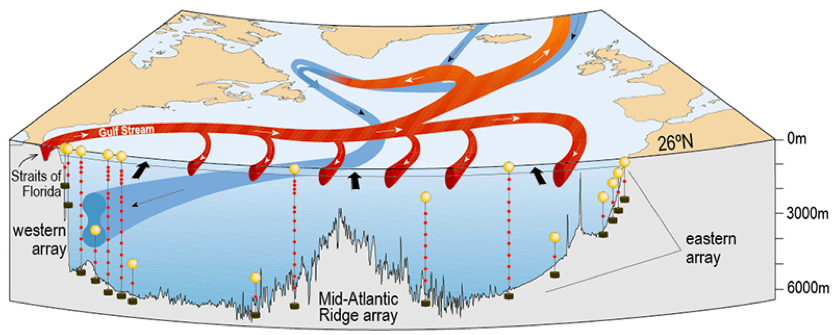
Lead supervisor: Francesco Muschitiello, Geography
Co-supervisor: Matt Osman, Geography
Brief summary:
Using laboratory and computational techniques, this project will extend the AMOC record to better constrain its vertical structure and variability in response to climate change.
Importance of the area of research concerned:
The Atlantic Meridional Overturning Circulation (AMOC) exerts an important control on the climate system on a wide range of temporal and spatial scales (Srokosz et al., 2012). Monitoring and reconstructing the variability of the AMOC is thus crucial for assessing future rapid climate changes. Since mooring observations began in 2004 (Bryden et al., 2005), the AMOC has steadily weakened. However, the observational record is too short to assess the natural variability of AMOC on multidecadal and longer timescales. More importantly, it is unclear how the mixing geometry in the upper and deep ocean layers impacts regional and global climate change. Climate-proxy records from the North Atlantic are extremely valuable as they can be exploited to provide a longer context to assess the dominant variability of the AMOC, its 3D structure, and ultimately its influence on the climate system.
Project summary :
This project will extend the AMOC monitoring record to better constrain the processes at the origin of AMOC variability in response to climate change. The project will leverage laboratory and computational techniques to generate new spatiotemporal reconstructions of ocean circulation to constrain the horizontal and vertical structure of the rate of AMOC across multiple timescales. This will be achieved by generating, compiling and assimilating marine geochemical climate proxies into state-of- the-art climate simulations. The resulting reconstructions will bring major constraints on the response of the AMOC to external and internal forcing mechanisms (Rahmstorf et al., 2007), e.g. insolation, freshwater flux, ice-sheet dynamics, and vertical mixing in the ocean’s interior.
What will the student do?:
The student will generate new AMOC reconstructions, providing crucial insights into the 3D structure of this system and the role of mixing geometry in the upper and deep ocean layers on North Atlantic climate. To support these broader aims, the student will i) generate new records using kinematic tracers from key North Atlantic sediment cores; ii) collate and interpret regionally dispersed marine geochemical proxy data; iii) generate consistent proxy chronologies using dating software, and; iv) compile, analyse and interpret pre-existing model and paleo-model data.
References - references should provide further reading about the project:
Bryden, Harry L., Hannah R. Longworth, and Stuart A. Cunningham. "Slowing of the Atlantic meridional overturning circulation at 25 N." Nature 438.7068 (2005): 655.
Kuhlbrodt, Till, Alexa Griesel, Marisa Montoya, Anders Levermann, Matthias Hofmann, and Stefan Rahmstorf. "On the driving processes of the Atlantic meridional overturning circulation." Reviews of Geophysics 45, no. 2 (2007).
Srokosz, Meric, Molly Baringer, Harry Bryden, Stuart Cunningham, T. Delworth, S. Lozier, Jochem Marotzke, and Rowan Sutton. "Past, present, and future changes in the Atlantic meridional overturning circulation." Bulletin of the American Meteorological Society 93, no. 11 (2012): 1663-1676.
Applying
You can find out about applying for this project on the Department of Geography page.